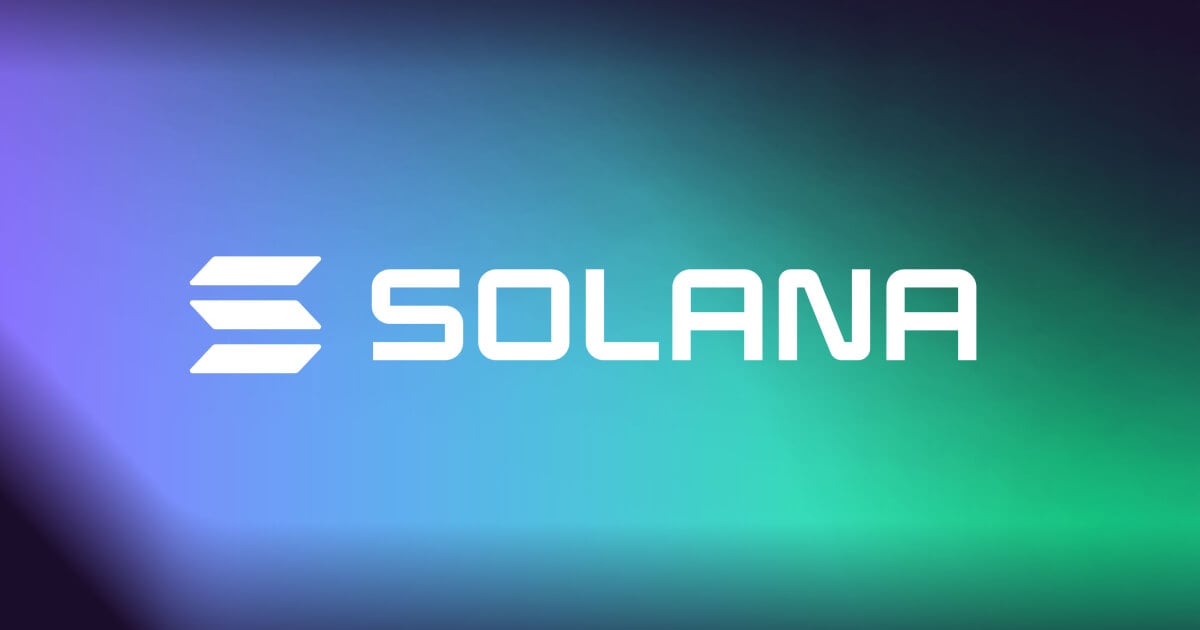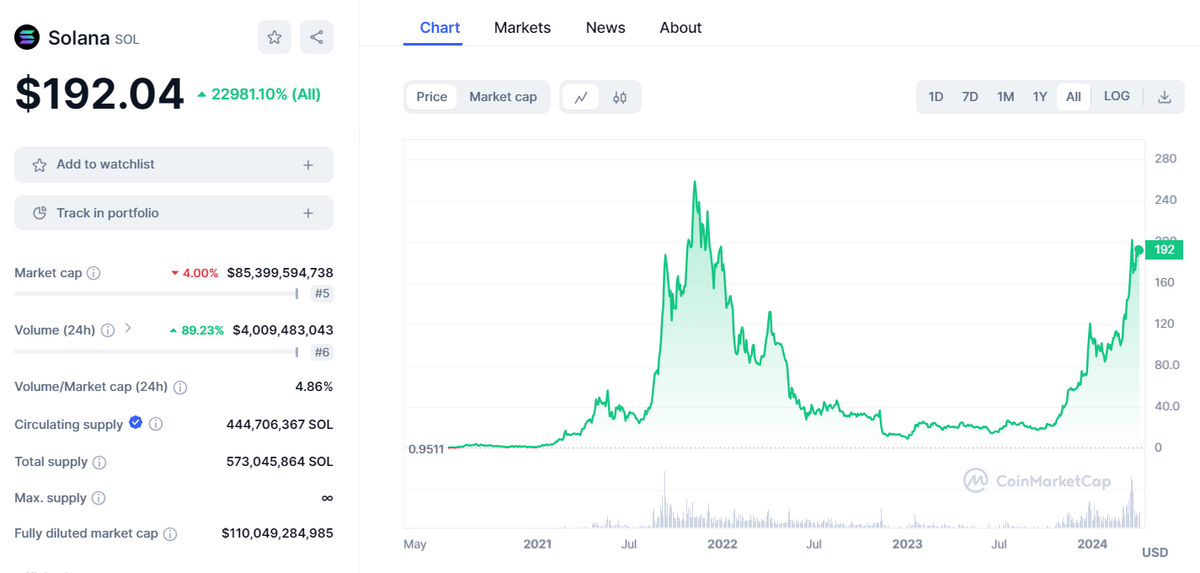
Like many cryptocurrencies, Solana’s history is checkered with blistering price explosions and devastated collapses. Founded by Anatoly Yakovenko, the Solana network has made a name for itself in the web3 industry, but it hasn’t always been for the right reasons.
While the Solana blockchain boats impressive tech and unmatched scalability, Solana has had its name dragged through the mud due to network outages, its relationship with FTX, and alleged centralization issues.
But despite its naysayers, Solana bounced back. The Proof-of-History (PoH) network defied all odds and returned stronger in late 2023 to become undoubtedly the industry’s largest alternative Layer One, threatening even kingpin Ethereum.
Sponsored
What are the twists and turns of Solana’s scintillating story?
Table of Contents
What is Solana (SOL)?
Solana is a smart-contract-capable blockchain known for its breathtaking speeds and minuscule gas fees. The network leverages a creative hybrid consensus mechanism that blends Proof-of-History and Proof-of-Stake (PoS) to enhance scalability, making Solana perhaps the most performant blockchain in crypto.

When the FTX crypto exchange collapsed in November 2022, it was widely assumed that it would spell the end of Solana, which was closely tied to FTX and its sister company, Alameda Research.
Sponsored
Yet, Solana fought back beyond anyone’s expectations, becoming the leading alternative Layer One chain in terms of most key metrics, like active wallets, TVL (total value locked), and transaction volume.
Solana History
How did Solana go from a creative idea bouncing around between surfers in California to one the biggest crypto projects in the industry?
Inception
In 2017, Qualcomm engineer Anatoly Yakovenko watched as legacy blockchains like Bitcoin and Ethereum struggled with scalability issues, high gas fees, and sluggish transaction speeds.
Seeking a solution, he published a whitepaper outlining a new algorithm of timekeeping within blockchain networks that would enable higher throughput and rapid transaction finality.
Yakovenko teamed up with Qualcomm colleagues Greg Fitzgerald and Stephen Akridge, and together, the three of them set to work writing the codebase that would one day become the Solana blockchain.
The three engineers imagined weaving all the world’s blockchain transactions into one smooth, seamless network and appropriately named their network Loom. Unfortunately, an Ethereum-based project had already claimed the name, forcing Yakovenko and co to rethink their approach.
They named their blockchain protocol Solana and the supporting company Solana Labs after the nearby beach where the three had regularly surfed together during their years at Qualcomm.
Mainnet Launch
Throughout 2018 and 2019, the Solana Labs co-founders worked hard to raise funds for their ambitious open-source network. Claiming to bring unprecedented speed and scalability to blockchain technology, it was no surprise that the project was met with enthusiasm.
Solana’s history really kicked into another gear during these early funding rounds, with investors and venture capital firms pouring in to get a piece of the pie. Led by firms like Multicoin Capital, Solana quickly raised over $20M USD. But that was just the beginning of fundraising efforts, the bulk of which would come after the chain was live.
The Solana blockchain officially launched on March 16th, 2020. At launch, the mainnet supported transfer functions and basic smart contract support but didn’t originally provide staking rewards to validators and node operators.
Explosive Success and Consequent Growing Pains
The year following the Solana blockchain progressed rather quietly. It churned away while developers updated and slowly improved the network, preparing it for wider adoption and the incoming surge of users that the next crypto bull run would likely bring.
2021 brought a completely different change of pace to the Solana blockchain. Buoyed by a surging crypto market, Solana’s fast network and low transaction fees made it an extremely popular choice among both users and investors.
After starting the year valued at under $3, the price of SOL tokens ripped to all-time highs of over $250 USD, making it one of the year’s standout performers.

Of course, Solana’s success wasn’t without its growing pains. The network was frequently overwhelmed by the sheer number of users, meaning the blockchain suffered lengthy outages, which meant that users could not access their funds, fearing that the network might never return.
The purist crypto community was also particularly scathing of Solana. Ethereum and Cardano’s supporters looked down on Solana, claiming it was a centralized VC chain with an on-off switch against all cryptocurrency’s fundamental principles, like decentralization.
However, every time Solana went down, the appropriate fixes were made, and the network slowly but surely became more stable and less centralized. Today, Solana boasts thousands of independent validators and has a better Nakamoto Coefficient score (the minimum number of entities that can collectively shut down a blockchain) than rivals like Ethereum, Avalanche, and NEAR.
FTX Collapse
Solana’s history wasn’t always sunshine and rainbows, but the network’s darkest day was undoubtedly when the FTX cryptocurrency exchange collapsed and declared bankruptcy. Thanks to heavy funding from FTX Ventures and Alameda Research, Solana’s success was closely tied to its support from Sam Bankman-Friend, the fallen crypto hero.
The FTX Collapse was devastating for Solana and was widely considered the final nail in the coffin that would destroy Solana’s reputation forever. SOL price crashed as low as $8, and some of the biggest projects and NFT (non-fungible token) collections actually abandoned the chain.
Would this be the sour end of Solana history?
The Return of Solana
Solana’s redemption arc is for the crypto history books. The network was thought to be nothing more than a dead-in-the-water, orchestrated pump-and-dump scheme played out on a massive scale.
Imagine the crypto world’s surprise when the Solana ecosystem turned things around throughout 2023 and 2024. The number of dApps (decentralized applications), products, and services being built on the chain increased, and even Visa announced that it preferred Solana for its stablecoin settlement pilot.
Decentralized finance exploded on the network, with meme coins like BONK and WIF onboarding tens of thousands of new users to the ecosystem. On-chain DeFi trading volumes competed with those of Ethereum for the first time in Ethereum’s history, all while Solana maintained smooth operations and didn’t suffer any of the outages that formally plagued the high-performance network.
What’s Next for Solana?
Looking ahead, the Solana Foundation is putting most of its efforts into the upcoming Solana Firedancer client.
The new validator client is expected to boost Solana’s speed and scalability to even higher levels, allowing the chain to support more users and provide apps and protocols with greater stability, all while maintaining Solana’s trademark low transaction costs.
On the Flipside
- Solana still has trouble being taken seriously by other crypto communities. For example, Cardano fans struggle with its history of centralization, while most Solana token standards aren’t as composable as developers might find on Ethereum.
Why This Matters
Solana is the second-largest Layer One blockchain in the industry. Knowing Solana’s history will help you better understand the ecosystem.
FAQs
According to data provided by CoinMarketCap, the circulating supply of SOL is approximately 444M.
The all-time high Solana price is $260. This figure was recorded on Nov 6, 2021.
You can buy SOL on crypto exchanges like Binance or Coinbase.
